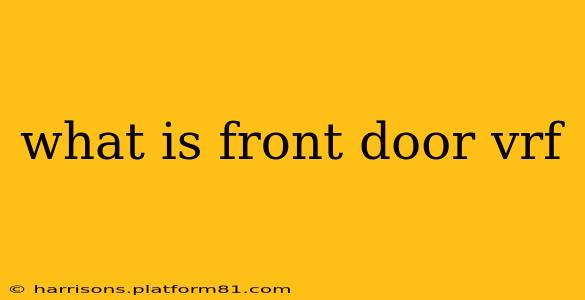Virtual Routing and Forwarding (VRF) technology allows a single router to support multiple independent routing tables, effectively creating isolated routing domains within a single physical device. A "front door VRF" is a specific implementation of this technology, designed to handle external network connectivity for a particular segment or application. It's essentially a dedicated VRF instance specifically configured to manage the ingress and egress of traffic from external networks.
Think of it like this: your router is a building with multiple apartments (VRFs). Each apartment has its own address and doesn't interfere with the others. The front door VRF is the apartment facing the street; it handles all the communication coming in and going out from the building to the outside world.
Why Use a Front Door VRF?
Employing a front door VRF offers several crucial advantages:
-
Enhanced Security: Isolating external traffic within its own VRF prevents potential security breaches from impacting internal networks. Even if a compromised device exists within the front door VRF, the attacker's access remains limited to that specific VRF, preventing lateral movement into sensitive internal networks.
-
Improved Network Segmentation: Dividing networks into VRFs enhances network segmentation, making it easier to manage, control, and troubleshoot individual segments. Changes within the front door VRF won't disrupt internal network operations.
-
Simplified Network Management: The dedicated nature of the front door VRF simplifies network management. Policies and configurations can be applied specifically to this VRF, streamlining administration and reducing complexity.
-
Multi-Tenancy Support: In multi-tenant environments (like cloud providers or service providers), a front door VRF enables different customers or applications to share the same underlying infrastructure while maintaining isolation and security. Each tenant can have its own front door VRF to manage their external connectivity.
-
Flexibility and Scalability: As network needs evolve, adding or modifying front door VRF configurations is generally straightforward, promoting flexibility and scalability without major disruptions.
How Does a Front Door VRF Work?
A front door VRF typically interacts with external networks through one or more interfaces. These interfaces are assigned to the front door VRF, and the routing protocols (like BGP or OSPF) are configured within the VRF to establish connectivity with external networks. Traffic entering the router destined for an internal network within a different VRF is routed accordingly based on the configured routing tables. Similarly, internal traffic destined for the external network traverses through the front door VRF.
This process relies on using a combination of techniques like:
- Route Distinguishers (RDs): These identifiers uniquely identify each VRF instance.
- VPN Routing/Forwarding (VRF-Lite): This is a common implementation mechanism for VRFs.
- Route Filtering: Carefully crafted Access Control Lists (ACLs) prevent unauthorized access between VRFs.
What are the Different Types of VRFs?
While the "front door" refers to a specific purpose of a VRF, not a specific type, understanding different VRF types helps contextualize its role:
-
Customer VRFs: Used to isolate different customer networks in a multi-tenant environment (e.g., a service provider scenario). A customer's front door VRF would be one type of Customer VRF.
-
Management VRF: A VRF dedicated to network management functions.
-
Internal VRFs: Used for internal network segmentation, separating different parts of the organization’s network.
What are Common Use Cases for a Front Door VRF?
- Data Centers: To securely connect internal servers to the internet.
- Cloud Environments: To isolate customer workloads and provide secure internet access.
- Service Provider Networks: To provide secure and isolated connectivity for multiple customers.
- Large Enterprises: To improve security and simplify management of complex networks.
Frequently Asked Questions
What is the difference between a front door VRF and a regular VRF?
The key difference lies in the purpose. A regular VRF isolates networks, while a front door VRF specifically isolates external network connectivity, providing a secure gateway for external traffic. A front door VRF is a type of VRF, with a distinct application.
Can I have multiple front door VRFs?
Yes, you can configure multiple front door VRFs to handle different external connectivity needs or to segment external traffic based on different security requirements or applications. This enables finer-grained control and enhanced security.
How do I configure a front door VRF?
The specific configuration steps depend on your router vendor and operating system. Consult your router's documentation for detailed instructions on configuring VRFs and associated routing protocols. This is a complex procedure requiring advanced network engineering knowledge.
This detailed explanation should provide a comprehensive understanding of front door VRFs. Remember that implementing and managing VRFs requires specialized networking expertise. Consult with qualified network engineers for guidance on deploying and maintaining VRF configurations in your environment.
